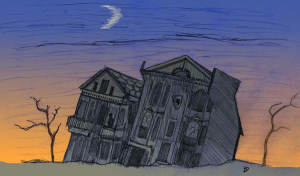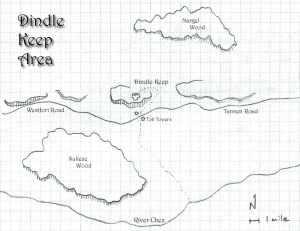The Thousand Eyes of Prince Sangor
This prince of a nomadic tribe is said to have a thousand eyes.
In actuality his tribe has over 500 warrior-aged men and women who act and fight in his name. As nomads, they are known to travel in many directions, even away from the tribe. They keep watch wherever they go, reporting news back to Prince Sangor through a specialized sending spell.
In person, the middle-aged prince can seem distant, since reports from his “thousand eyes” stream in constantly. To his credit, he is amazingly attentive for someone who has the central node in a hive mind in his head at all times.
The prince rarely sleeps for more than a few hours (whenever his “eyes” sleep, he is able to), leading many outsiders (and even some closer to him) to question his humanity. However, to many he comes off as a kind and generous leader who believes very strongly in core principles of honesty and justice.
The story element here is that the prince’s counsel has gone missing, and he has been unable to sort through the many messages that fill his mind. The party will be sent on a search and rescue mission across the desert in order to win his trust. Sandor’s top archers will accompany the party, and will teach those who use bows how better to use them. They will, of course, be able to be impressed.
Posted in Uncategorized and tagged campaign plotline, desert, nomad by Stephen Hilderbrand with no comments yet.
Fallon House
 This location is inspired by the work of E.A. Poe, though none of it explicitly derives from his work.
This location is inspired by the work of E.A. Poe, though none of it explicitly derives from his work.
This three-story dwelling is characterized by its distinctive lean. Each of the floors melds into the others, with very few staircases. Instead small one-step and two-step passageways pass from floor to floor, leaving all but the most astute dungeoneers disoriented. The corridors within are also oddly-shaped, starting wide and ending narrow. Ornate doors lead to rooms which face the outside in all cardinal directions, and a raised passage leads from the second floor main hallway to a two-story gazebo out back.
Throughout the house, cobwebs fill the corners, and a layer of dust coats the furniture and floors. Small animal footprints gather around the central hearth and lead off in all directions. Bats and giant caterpillars complete the ecosystem, in the broken rafters and under loose floorboards, respectively. Under these floorboards are old catacombs which predate the house itself. These catacombs can be cited as another reason for the lopsidedness of the house.
Outside, the barren trees have long-since grown away from the house, all they can do to distance themselves from the darkness within. A darkness that grows with each passing night. The timbers themselves have rotted from the inside, just like the human denizens of Fallon House.
The Fallons were once skilled translators of ancient texts, counting the most prominent political figures among their clientele. Since those halcyon days, however, the eldest couple in the Fallon household faced marital problems, eventually disintegrating the marriage. This collapse of the foundation of the family had visible physical effects, leaving the house and family lopsided as relationship upon relationship ended. The inhabitants left the house, one broken relationship at a time, until it was left deserted, as it has remained for a few years now.
This location holds many ancient secrets in the moldy tomes still within. It also hosts many creatures, as mentioned above.
Drawing by Ben Dare.
Posted in Uncategorized and tagged campaign plotline, Location by Stephen Hilderbrand with no comments yet.
The Story of Silas Dindle
 Silas Dindle is a local baron with a keep along the road between Tannen and Chez. The small barony has profited from the trade route that runs from Westfort to the capital.
Silas Dindle is a local baron with a keep along the road between Tannen and Chez. The small barony has profited from the trade route that runs from Westfort to the capital.
Lately Silas has been acting strange, insisting that his twin teenage daughters (who look only remotely alike) remain in his keep out of fear of having it overrun with goblins if they leave. It’s as if he sees them as guardians of the keep, though he employs a full retinue of soldiers to guard the keep itself. This has created some friction between him and his daughters, who wish to travel to Tannen to enjoy the prime of their youth. The Jæruel is beginning to threaten to step in if he is unable to gain control of the situation and explain why his daughters cannot leave the keep and why his men have been unable to provide escorts along the nearby roads. They too have been pressed into a new service, that of protecting the daughters so they can protect the keep.
Lady Dindle is long gone; she died during their birth some fifteen years ago. Silas has mourned her ever since. If the party visits the small graveyard at the rear of the castle, they will learn this, and her ghost will visit the party and tell her side of the story, a tale of wanting to keep her man happy while at the same time losing herself in him. They were unable to conceive, and instead she was impregnated by one of his god’s angels, giving birth to the half-angel beings that protect the keep. At least that’s her side of the story.
Plot Resolution
It turns out, they were able to conceive, but Lady Dindle died with the twin daughters, who were replaced with angels (Antaigne and Emmaigne) on earth due to Silas’ devout nature. Recent events, including his joining the Jæruel have led him to question his god and perform acts which are considered less devout by his god’s followers, including overtolling the local merchants and imprisoning a merchant who asked for one of his daughters’ hands (Emmaigne, the younger of the two) in marriage. The party will need to restore Silas’ faith by helping him perform a series of heroic deeds. This will enable him to retain the angels and thus his sense of fatherhood, and maintain a reason for living.
(map of the keep to follow in a later post)
Posted in Encounter and tagged campaign plotline, Jæruel by Stephen Hilderbrand with no comments yet.
The Basilisk of Weldon Estate
The many generations old Wheldon Estate has a proud history as a mercenary’s retreat. However, its recent history is less shared by members of the family, as it has been abandoned for decades by men. Rumor has it that a Wheldon once returned from an adventure in a farway land with a lizard pet, which overgrew its bonds and took hold of the estate’s central house. Following the departure of the family from the region, embarrassed by the events that followed, the local magistrate has assumed ownership the country estate at the edge of town. They have an open challenge, which if accepted and completed, will present the party with a vast reward.
How to use this plot outline in your game
Introduce this plot point as a rumor in a local bar, or as a tale told by a merchant or mercenary the party encounters in their travels. Build up the estate grounds with gruesome details, such as statuaries containing ornate, realistic-looking works (which are petrified humans, elves and dwarves which have accepted the local magistrate’s challenge) and dead, overgrown trees.
The party should first visit the magistrate to learn the conflicting details. The idea is that the basilisk has occupied the estate for over ten years, so the stories and tales have been embellished out of control. The party shouldn’t know exactly what to expect. Use your judgement as the storyteller, and make it convincing.
One thing that is clearly stated by the magistrate is that if they take back the estate, they get to own it. This is likely a motivating factor in the party’s accepting of hte mission.
Posted in Uncategorized and tagged campaign plotline, short adventure by Stephen Hilderbrand with no comments yet.
Divine Liberation
I’d like to dedicate today’s post to E. Gary Gygax, who has just passed away. Gary’s adventures surrounding Tharizdun were a major inspiration for this idea, and so it seems appropriate to dedicate it to him. Of course, this small thing is nothing compared to the joy and inspiration I have received because of him and his work. I write this in the spirit of sending thanks and help to those who are no longer in this world.
This campaign plot line turns a common thread around.
Generally, an imprisoned deity is the bad guy that the PC heroes are trying to keep locked up. In this reversal of the story, a benevolent deity that the PCs worship or care about has been imprisoned.
This could be a long story arcing over a campaign, or a shorter story for higher level characters.
If used for a long campaign, the imprisoned deity may have been trapped long ago, and now some prophecy or omen has involved the PCs with it’s release.
If a short story, the deity may have just been recently tricked or put upon by another, malevolent or jealous deity, and the PCs must help the god overcome it’s tribulations. The part they play may be a minor, but pivotal part in a larger effort.
Posted in Uncategorized and tagged campaign plotline by Adam A. Thompson with no comments yet.
